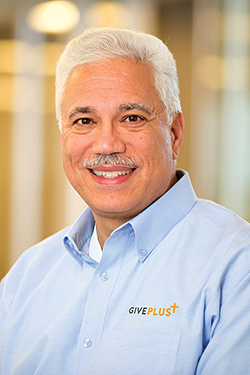

GivePlus eGiving Ambassador
Vanco Payment Solutions
What do churches need to know about the correlation between digital giving and engagement — especially if they haven’t thought about it before?
Richard A. Bauer: In my experience — having dealt with many Christian churches across the country — those who are excelling at digital giving are also leveraging the digital features of their church management software (ChMS).
The digital giving functionality is merely an extension of what you do with your ChMS. So, these churches are reaching out to not only thank their givers, but to also give them specifics on how their gifts are impacti ng ministry locally, or even internationally. They’re essentially doing what well-recognized nonprofit organizations have done for many years: always recognizing the giver, regardless of the size of the gift.
Mark Walker: Engagement is the new attendance. Churches that focus mainly on attendance will decline. We need to focus less on attracting people, and more on engaging with them. Today, because of the internet, there are many ways to be engaged beyond attendance. Digital giving is one of those ways. Many churches, not just mega churches, are streaming services on Facebook Live. Because of the

Chief Operating Officer
Generush Giving & Former Pastor
ease of use and low- to zero- cost of Facebook Live, small churches are streaming and seeing increased levels of engagement. Some of that engagement results in viewers giving online. Pastors often convey messages to us like, “I have people giving to our church that live across the country and will likely never attend our church, but they have bought into (engaged) our vision.”
Digital giving is not just an additional option for your attendees to give (which is a great tool), it also needs to be leveraged as an opportunity for others who may or may not attend your church to become engaged.
Why do some church leaders resist digital giving?
Walker: While digital giving may be a large step for many churches, a lack of understanding can cause apprehension and intimidation in making the decision to proceed with an online solution. We want to see churches make a larger impact in their communities, so we focus on the education of our system. For example, a complete donor management system, multi-lingual interface and campaign management. Digital giving becomes less intimidating when church leadership has a clearer picture about investment, integration and implantation.
We also often hear church leaders say, “We’re just a small older congregation. I don’t think we need digital giving.” However, more than 60 percent of adults over age 65 claim to be online in some form, whether it is buying a book on Amazon or keeping up with their grandkids on Facebook. The opportunity for them to remain engaged in the life of the church, even if their health prevents them from attending, is water to their souls.
“When you think about who’s often managing eGiving in a church, they don’t want to feel like they have to become Steve Jobs to figure out the platform.” — Richard A. Bauer
Bauer: The most common reason we hear is, ‘Our members are primarily older people.’ But we just completed the second edition of our Churchgoer Giving Survey [ https://hubs.ly/H0cSWXZ0 ], and one thing really stood out: Older members (55+) are actively engaging digital means, whether it’s for communication or for transactions. So, the individual who states that ‘Our members are primarily older people’ is oftentimes just expressing his or her own perceptions or opinions on the potential use of eGiving by older members.
Based on our findings, even if the technology is a little intimidating at first, it’s an opportunity for younger members — for whom, quite frankly, this technology is all they’ve ever known — to do some reverse mentoring.
Plus, there’s this notion that you have to give digitally every week. You can if you want, but recurring giving means you can can set it up so that a transaction happens every week, once a month, once a quarter, once a year and so on.
In what ways can a church mobilize its platform to attract first-time contributors?
Bauer: First-time contributors are the easiest community to present to; they’re your newest members. So, make sure that eGiving tools are always identified within the new member packet. If there’s a website, a mobile app they can download, or a text-to-give number they can use, make them aware.
Walker: If the launch alone of your digital giving platform attracts first-time contributors, they probably wanted to give to your ministry already and were waiting for a digital option. To think that your digital giving platform is a stand-alone tool to attract new givers may be a little presumptuous. We need to challenge people to give and show how giving digitally is an easy and measurable way to contribute to the ministry.
One of our pastors stood up on a Sunday morning and presented the vision for a project the church was involved in. He took out his phone and instructed everyone to do the same. He then put the giving link on the video screen and said, “Let’s all do two things right now. Let’s all give at least $5.00 from our phones to this cause and try to break the giving system at the same time.” Two things happened that morning, a church of about 300 raised $15,000 for that cause, and 20 percent of the contributors were first-time givers. And no, they did not succeed in breaking our text and online giving system. Text giving is a clear and simple way to engage new donors. Create a reason for people to send a text and start the donation process quickly.
What about moving first-time contributors to more regular givers?
Walker: Converting first-time contributors to regular givers is the fun part. Celebrate! Celebrate! Celebrate! What gets celebrated gets repeated. A first-time contributor should never be left to be thanked only by the giving system; they should receive a call, letter or personal email that celebrates this step and explains to them what their contribution is doing in the kingdom through your church.
Bauer: Right now, we’re celebrating our 20th year serving churches in the electronic giving field. The whole experience started out with electronic funds transfer. And here we are now, in text. We’ve even seen some churches that are accepting BitCoin.
The point is that it’s critical to acknowledge that members, new members and visitors all have their own preferred way of giving. Young people like using text and a mobile app. People in their 40s and 60s often like to log onto the church’s website and click the “donate” button. There’s a different flavor for everybody.
Churches need to understand this and decide if they’ll make those options available.
How can a digital giving platform be used to encourage solid, consistent givers to keep giving — and even inspire them to increase their contribution levels?
Bauer: Every year, there’s the opportunity for everybody to revisit their commitment to their community of faith, and whether or not they’re in a position to change that. People must also recognize that the giving they agreed to for their Sunday commitment does not necessarily reflect all the giving that might transpire through the course of the year.
For example, I might have set up a weekly gift as part of my Sunday offering. Let’s say that’s $100 a week. But, other activities are going to manifest themselves. At my little church, for example, it’s an annual event called the “One Great Hour of Sharing” that happens every March. Perhaps, rather than logging onto the website, I want to give through my mobile app.
“Engagement is the new attendance. Churches that focus mainly on attendance will decline.” — Mark Walker
Or, maybe it’s shared in a story of ministry that we support, and I want to give via text because it’s more convenient. As a giver, you want there to be one place where you can log in and get regular updates, and that’s where church management software comes in. It can offer a recap to an individual giver of what they gave quarterly, which fund(s), and more. What it boils down to is, your members are looking for the same kind of detail in their church life that they’re already enjoying in other parts of their digital life.
Driving retention through digital giving comes down to engagement. Just because a person has set up a recurring gift, doesn’t mean he or she shouldn’t be acknowledged for that. What does it cost to turn on the functionality in the app to push out an email of gratitude? Nothing, other than the initial effort.
Walker: When you connect the dots between giving and life change, people are more likely to keep giving. Your digital giving receipts should be filled with things like, “Because of your generosity, First Baptist can continue to provide practical help to single parent families in our community…”
Pastors should thank digital givers as a whole from the stage/pulpit every week. This not only helps those donors feel known and needed, but it reminds those that digital giving is always an option. It also changes mindsets from ‘we have to give’ to ‘we get to give’ and when we get to do more of what makes us come alive on the inside, then we’re more willing to up the ante!
If a giving data shows that a regular, consistent giver’s contributions have dropped off (or ceased), can the church use its digital giving platform to re-engage that individual?

Walker: To think that our giving platforms can replace the intentional, personal connection of gratitude would be like bowing our head during someone else’s prayer, then never feeling the need to pray again. If a giver’s contributions are decreasing or have stopped altogether, no giving platform is smart enough to tell us why. Church leadership needs to be intentional in using their platform to monitor and measure giving and be bold enough to reach out and have some conversations. In my experience, the giver has encountered a financial / life challenge, an emotional or spiritual disconnect. Or there’s a trust issue that has developed. Using a tool like Cause Subscription on Generush to keep contributors up-to-date on finances and ministry milestones will help donors connect and be part of something larger than themselves.
Bauer: This is where we need to physically get out there and meet with that person, face to face. Or, we need to make a phone call. We can say, “I haven’t seen you as much in church. Is there something going on? Anything I can help with?”
If a church isn’t confident in its digital giving platform’s ability to help retain and expand supporters, what should they know as they ‘shop around’ for something else?
Bauer: This is extremely important because, for many churches, the staff is volunteer, maybe part-time. When they have a question about the eGiving platform, being able to pick up the phone and talk to somebody who’s dedicated to being able to serve them, is extremely important. So, ask yourself: Does this company have available operators who understand the church space and the pressures volunteer and paid staff are under to try to get everything done with limited time?
After all, when you think about who’s often managing eGiving in a church, they don’t want to feel like they have to become Steve Jobs to figure out the platform or how to make simple changes to the application.
Walker: First, users need to identify what they don’t like, and what they wish their current platform could do differently. Then, when you find a platform that you would like to explore a little deeper, don’t contact them right away. Find an organization or two that uses that specific platform and contact them. Ask questions about fees, hidden costs, customer support, and donor experience… things that are driving them to make a switch. No one digital giving platform is a right fit for every single church. There are just about as many giving platforms for churches as there are churches for people. And that’s a good thing.
What about cost? How important should that be?
Walker: A common objection with digital giving is the cost. The idea of a credit card fee being removed from the tithe before it gets to the church is not a favorable one. We try to help church leaders understand that digital giving opens the door to new givers. If the only goal is to move all givers over to the digital platform, then there is a net loss due to fees. However, if you engage one new giver, you’re not losing 2 percent of a donation that was $100, you’re adding $98 of a donation that was originally $0. In most cases, it only takes one new regular contributor to cover the additional cost of a digital giving platform for the entire church. What’s the value of connecting one more person the goodness of God through generosity?
Bauer: Well, yes, there’s a cost. Just like there’s a cost to keep the church cool on Sunday when it’s fast approaching 100 degrees outside. Just like the cost to provide free Wi-Fi to members and guests.
And really, there has always been a cost associated with giving, most often in the form of time spent to manually process gifts. The best way to anticipate the cost for your church is to visit our website or call (855) 595-2552.
Fortunately, digital giving has the ability to help a church avoid the summer giving slump. When people are able to set up a reoccurring gift, the church is still supported even when members are on vacation. That’s the first victory.
Additionally, if the cost of the eGift is an issue for the church, our platform offers an offset-fee functionality. This gives church members a chance to pay for the cost. So, if I want my church to receive the full $100 gift, I can give $103 and get recognized for the full gift. Then, the church received the net $100 gift.
— Reporting by RaeAnn Slaybaugh


